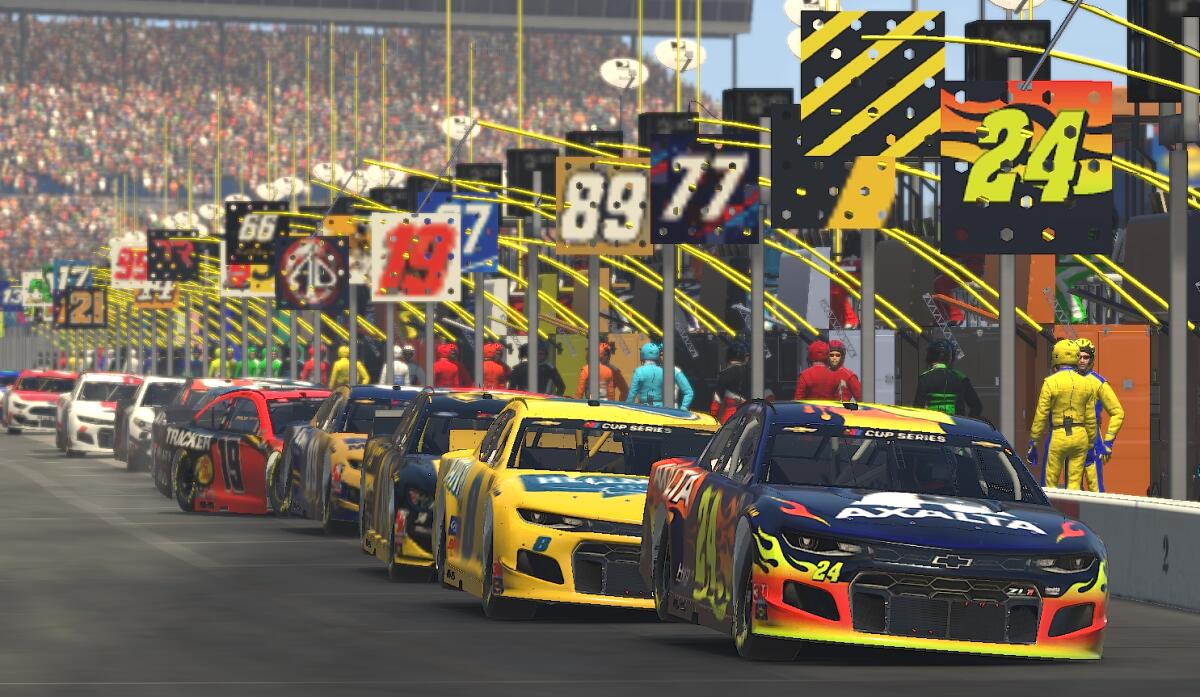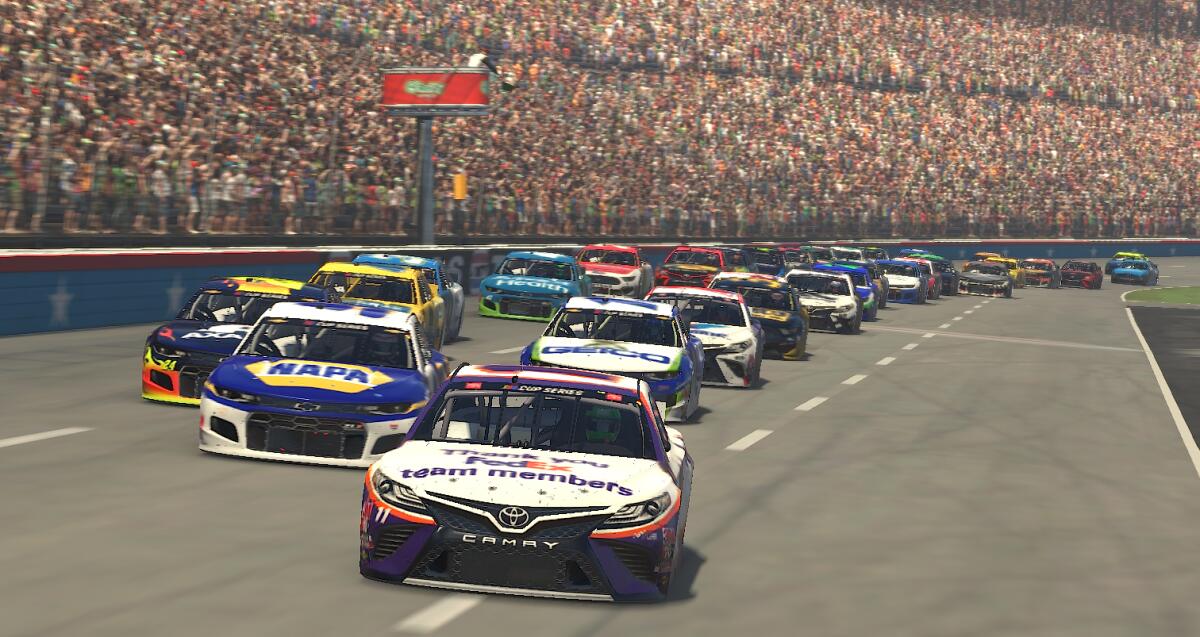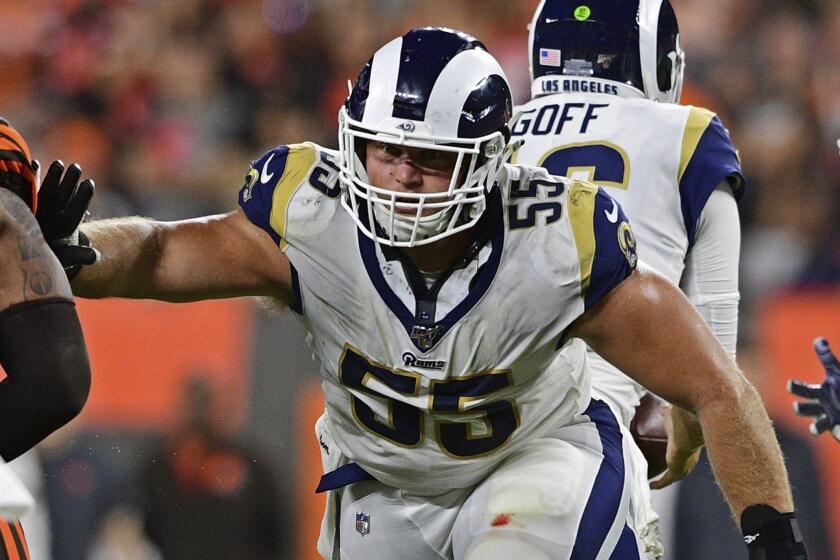NASCAR’s iRacing format brings excitement of virtual track to TV

- Share via
As he drove to Fox Sports’ Charlotte studios Sunday morning, Jeff Gordon felt that familiar buzz of race day.
“I got excited when I woke up,” the retired NASCAR legend and current television analyst said. “Knowing that I was going to get to go see a race, I was going to get to broadcast a race, be a part of it.”
Not a real race, of course. Not now, anyway. Like the rest of the sports world, NASCAR has suspended its schedule because of the coronavirus outbreak, its drivers stuck at home while its monolithic venues sit empty and eerily quiet.
Back in Fox’s Charlotte studios, however, Gordon has been hard at work the last two Sundays broadcasting races of a different variety. In the TV time slots originally dedicated to NASCAR, computer-generated images of an iRacing competition have aired, a video-game broadcast that had the look of a virtual presentation but the feel of something much more substantial.
“I don’t know what to call it,” Gordon laughed. “I guess you’d call it real racing. Our normal broadcast has now become iRacing.”
A look at how sports leagues, including the NFL, MLB, MLS, NBA and NHL, are responding to the coronavirus outbreak.
Virtual simulators are nothing new to auto racing, used as important training tools by almost every major racing team. iRacing turned the concept into an actual competition though, allowing drivers to race against each other from the comfort of their homes.
“I always thought it was a cool concept,” Gordon said. “But I never knew it could do what it’s capable of doing today, to put the sport on a broadcast.”
The eye-catching product has produced eye-popping results.
With a roster of 35 NASCAR drivers headlined by semi-retired Dale Earnhardt Jr., Kyle Busch, Jimmie Johnson and Denny Hamlin, Fox’s two “eNASCAR” broadcasts together have drawn more than 2 million viewers, dusting previous eSports television rating records at a time all other sports are stuck in neutral.
“There’s a lot of things that made NASCAR and iRacing a perfect candidate for this,” said Brad Zager, Fox Sports executive vice president and head of production. “It’s a simulator rather than just any other eSport. You’re not just hitting a joystick … These drivers have rigs and it really feels like racing. They’ve got to deal with shifting and the issues in the track they normally would deal with.”

Founded in 2008, iRacing carved out a niche within the racing community over the last 12 years among fans and drivers alike.
Some professionals use it to learn new tracks. Others to keep hand-eye coordination sharp. According to iRacing’s executive vice president and executive producer Steve Myers, most simply enjoyed the competition.
“They all got into racing because they love racing,” Myers said. “So to be able to go to a software platform like ours that more closely, more accurately represents what racing is ... it’s fun for them to do.”
It’s all that we have right now. With sports shut down across the world because of the COVID-19 pandemic, esports generates new players and fans.
While iRacing — which is currently staging similar virtual series for Formula One and NASCAR truck racing — can’t replicate all the physical sensations of stock car racing, it does force drivers to make the same mental calculations. Go for a pit stop or stay on the track? Attempt a pass or maintain position in the pack? Slow down through a turn or risk smashing into the wall?
“In the real world, you feel the air moving in the window, you feel it in the seat. The loads on your body tells you what the car is doing,” Gordon said. “In this world, it’s visual.”
NASCAR drivers have taken it seriously. Timmy Hill, who won Sunday’s race, spent so much time preparing for the race that his wife, Lucy, started asking, “When are you going to come downstairs? You’ve been on this thing all day.” After his win, however, she was the one to deliver the ceremonial glass of milk as they celebrated in their home.
“I definitely rank it up there,” Hill, who has yet to win a NASCAR event on a major series, told reporters when asked how the virtual victory compared to his other career achievements. “Just because the platform is being televised on Fox, having essentially the entire NASCAR audience tuning in.”
Others in the industry are also toasting to the success of eNASCAR, which will continue until actual racing resumes.
After reaching peak popularity early this century, the NASCAR’s popularity has spiraled in recent years. The days when Gordon, Earnhardt Jr. and Johnson captivated capacity crowds and headlined television broadcasts of almost 6 million television viewers are gone. Last season, the average NASCAR race attracted about 3 million viewers, according to Statista, and swaths of empty seats were noticeable in grandstands across the country.
The virtual races won’t reverse those declining trends. But they offered up a timely reminder of just how relevant racing can still be.
A look at athletes, coaches and others in the sports world who have tested positive of the coronavirus.
“It’s proven out beyond our wildest dreams of being a tremendous business story,” said Scott Warfield, NASCAR managing director of gaming. “It’s having an impact on company morale and giving employees something to rally behind in a very tough time. There’s a fan benefit, there’s an industry benefit, and there’s a business benefit where you have a lot of partners that were able to help at a time when some of that exposure could have been lost.”
The phenomenon is loosely reminiscent to NASCAR’s coming-out party in 1979. That year, the first full national broadcast of the Daytona 500 coincided with a massive snowstorm that kept much of the East Coast and Midwest inside, introducing the sport to a country-wide audience for the first time.
Today’s COVID-19 circumstances are much bleaker, and the impact of these virtual races will surely be much smaller in scale. Few other television programs, sports or otherwise, have provided a better large-scale distraction.
“This is an opportunity, with everything going on in the world right now, to step away from that for a short period of time,” Gordon said. “To go have some fun and be able to do some racing that is as realistic as it gets.”
More to Read
Go beyond the scoreboard
Get the latest on L.A.'s teams in the daily Sports Report newsletter.
You may occasionally receive promotional content from the Los Angeles Times.













